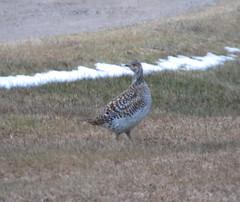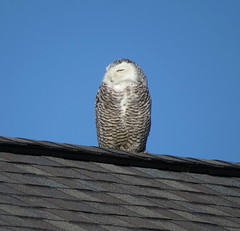Port William, Ohio (Clinton County)
Located 8 miles North of Wilmington Ohio, situated at the junction of Route 134 and a “little slice of heaven” the tiny village of a little more than 250 residents probably don’t get a lot of visitors, especially birders. This sleepy little hamlet is “Small Town America” with a cherry on top as Phil and myself are about to discover.
Reports came in about 5 to 6 days ago about a sighting of a small group of Eurasian Collared-Doves (Streptopelia decaocto) making Port William their home. This Eurasian species introduced to the Bahamas started to spread to Florida in the late 1970’s. There it quickly established themselves till it spread Westward in the 1990’s, where it’s reached the West coast. However if you look at it’s range map it’s considered a rarity in the Eastern portion of the United States. This is our target bird tonight as I pick up Phil at 6:30 pm and make our way towards Port William. This would be a life bird for Phil and I’m excited for him. My life bird was sighted at the Magic Kingdom. While making our way through the massive theme park, I saw the large dove land on a lamp post in front of Cinderella’s Castle. Since the family was more excited about getting to the next attraction, my only exposure of this bird was a quick ID through my bins, which by the way never left me all the time I was there.
As we entered the village the first spot we stopped at was the grain elevators/silos at the edge of town. There was good bird activity, which is normal for any grain silo, with lots of Doves. I noticed what looked like a Eurasian Collared fly between 2 silos and disappear. Could we have found them this quickly, we’ve only been here just a few minutes? Sometimes it’s better to be lucky than good, and we were lucky tonight as Phil pointed out one perched on the electrical line right next to us. Quickly retrieving my camera I was able to get off a couple of shots before it took off.
 What you want to look for in field marks is the squared off tail. Mourning Doves come to a point. Lighter in color overall with a dark crescent around the back of the head. Also it’s call is different than the Mourning Dove.
What you want to look for in field marks is the squared off tail. Mourning Doves come to a point. Lighter in color overall with a dark crescent around the back of the head. Also it’s call is different than the Mourning Dove.
 In this picture (which was one hell of a lucky shot) you can see how the tail is squared off with the tail feathers being a little lighter in color at the corners. You can really see the crescent collar on this picture.
In this picture (which was one hell of a lucky shot) you can see how the tail is squared off with the tail feathers being a little lighter in color at the corners. You can really see the crescent collar on this picture.
Completely satisfied with our quick discovery it was a shame to leave so soon, so we drove around town and looked for more. As one would expect traffic wasn’t much of an issue as we stopped frequently at any Dove we saw. We turned around at the far edge of town at the local cemetery and made our way back to another set of grain silos that we didn’t check out.
 This small river to the left in the picture flows underneath Route 134, with the other set of grain silos on the opposite bank. It was this set of silos was where Phil and myself saw the most of the Eurasian Collared-Doves. The first report out of Port William was of 5 individuals, and tonight we saw what we thought were 4 individuals.
This small river to the left in the picture flows underneath Route 134, with the other set of grain silos on the opposite bank. It was this set of silos was where Phil and myself saw the most of the Eurasian Collared-Doves. The first report out of Port William was of 5 individuals, and tonight we saw what we thought were 4 individuals.
 What I love about this picture you can really see the underneath coloration of the tail. Look at the white patch that you don’t have on a Mourning Dove.
What I love about this picture you can really see the underneath coloration of the tail. Look at the white patch that you don’t have on a Mourning Dove.
 As you come into town this will be the first set of grain silos you’ll come to, with this lovely spill-way where I’m sure a mill was located at one time.
As you come into town this will be the first set of grain silos you’ll come to, with this lovely spill-way where I’m sure a mill was located at one time.
I love little trips like this and wish I could do them more often. Happy as any birder would be, after about 45 minutes or so, we packed it in and left Port William for home

























